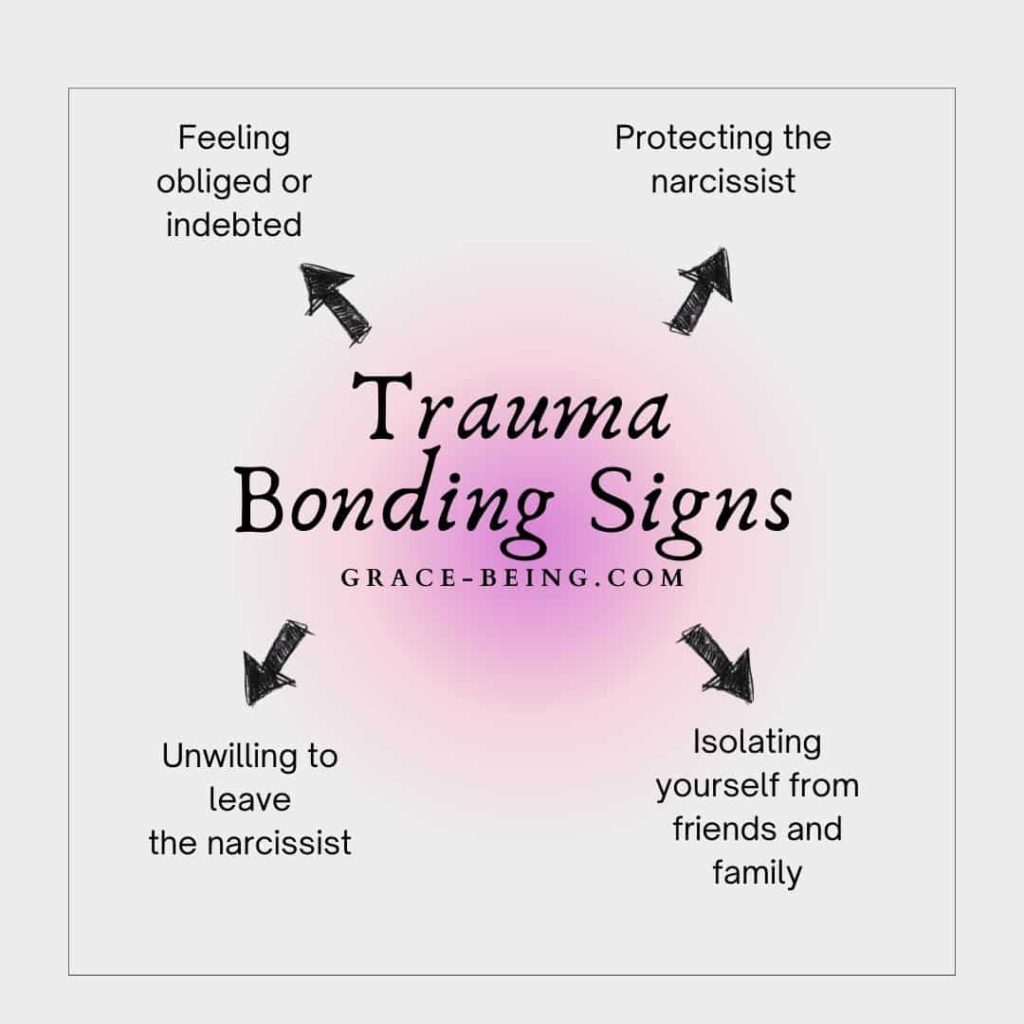Trauma Bonding With Narcissists: What Is It?
Are you in a toxic and abusive relationship with a narcissist and cannot understand why you’re still in it?
Do you struggle to make sense out of things and what’s happening to you?
Are you feeling isolated because no one understands why you’re still in a toxic relationship?
Victims of narcissistic abuse most often don’t realize that they have formed a trauma bond with their abuser. Trauma bonding with narcissists is the reason why victims get stuck in abusive relationships, even if they’re unhappy and feel mentally exhausted.
If you’re interested in healing from narcissistic abuse, I warmly welcome you to my Narcissistic Abuse Recovery Program. It’s an easy self-paced online course which you can do at your own pace. My signature program combines scientific and spiritual tools for holistic healing of the body, mind, and spirit.
What is trauma bonding exactly?
Why do people stay with a narcissist and put up with their abusive and manipulative behavior?

What is trauma bonding with a narcissist?
Trauma bonding with a narcissist is a result of intermittent positive reinforcement by the abuser.
This means that the narcissist alternates between manipulative abuse and love bombing which leads to the development of trauma bonding.
The more time passes, trauma bonding with narcissists strengthens. Victims become weaker and more submissive, craving validation and approval from their own abusers. Narcissists positively reinforce certain behaviors, and they do this intentionally to manipulate their victims and keep them stuck in the relationship.
As the narcissist gains more control, it becomes more difficult for a person to become aware of the abuse and manipulation. Victims feel confused and experience cognitive dissonance due to narcissist gaslighting.
Moreover, when a person develops trauma bonding with a narcissist, they keep hoping and waiting for positive reinforcements to relieve them from their emotional suffering and the feeling of rejection.
Trauma bonding caused by narcissists conditions people into believing that these toxic behaviors are normal. Victims of narcissistic abuse might be fully aware that they are with a toxic person.
However, due to the trauma bonding with the narcissist, they become conditioned to continue forgiving them. This makes it almost impossible to leave, and they end up stuck in an abusive relationship without being able to assert solid boundaries.
This is not what a healthy and loving relationship looks like. A truly loving partner makes you feel loved, supported and accepted throughout the relationship. Getting mistreated because your narcissistic partner has a bad mood, or because you didn’t feed him/her with narcissistic supply is completely unacceptable.
How long do trauma bonds last?
Getting over trauma bonding with a narcissist is one of the hardest things to overcome due to trauma bond withdrawal symptoms. It becomes like a psychological addiction and victims end up craving their abusers’ positive reinforcement. This addiction is a result of the push-pull in the relationship over many years.
Trauma bonds can last from several months up to a few years. For some people it might not fade away completely and can take longer to fully recover. The impact of the confusion, lack of closure, and cognitive dissonance caused by narcissists can make the trauma bond last longer.
So it is crucially important to learn about narcissism and understand the psychology behind. This is the best way to deal with the confusion and will help you obtain closure to start the healing process.
What are the signs of trauma bonding?

Here are some of the common signs that a person is experiencing trauma bonding with a narcissist:
- Feeling obliged or indebted – narcissists are good at making someone feel as though they are always indebted to them. For example, if you made a mistake early in the relationship that hurt them, they will hold that grudge and keep reminding you about it. They do it intentionally to make you feel bad so you make it up to them. They can make you feel guilty and terrible about the smallest of things, and condition you to feel ashamed for past behaviors.
- Protecting the narcissist – you feel like you need to protect your partner especially if someone makes them feel awkward in social situations as you know their ego is fragile. You might also justify their behavior and try to protect their reputation when they engage in erratic behavior.
- Unwilling to leave the narcissist – despite being unhappy in the relationship, you resist taking the necessary steps to break the trauma bond and leave the abusive relationship.
- Isolating yourself – you might be arguing with your friends and family as they advise you to leave your abuser. So you end up avoiding them or distancing yourself from people trying to help you.
Learn more in depth about the trauma bonding signs with a narcissist.
Examples of trauma bonding with a narcissist
Trauma bonding with a narcissist can manifest in numerous ways. Here, we’ll dive into some specific examples that encapsulate the essence of this disturbing psychological phenomenon:
- The Cycle of Abuse and Apologies: One of the most common examples of trauma bonding is the narcissist’s ‘abuse-apology’ cycle. In this case, the narcissist subjects the victim to emotional, psychological, or even physical abuse.
Following these episodes, they may shower the victim with affection and apologies, promising that it will never happen again. This intermittent reinforcement of negative and positive behavior creates a strong trauma bond, making it difficult for the victim to leave the relationship. - Excessive Control and Isolation: Narcissists are known for their controlling behavior. They may manipulate their victims into cutting off contact with friends and family, thereby increasing the victim’s dependency on them.
This control and isolation are key elements in the trauma bonding cycle, where victims feel they have no one to turn to apart from the narcissist. - Gaslighting and Reality Distortion: Narcissists often use gaslighting to make their victims question their own perception of reality.
This manipulation tactic can lead to self-doubt and confusion in the victim, reinforcing the trauma bond as the victim becomes more reliant on the narcissist for their sense of reality. - Jealousy and Possessiveness: A narcissist’s jealousy can often lead to possessiveness and control over their partner’s activities. They may demand excessive attention and react negatively when their partner interacts with others.
This can create a narcissist trauma bond as the victim starts to change their behavior to please the narcissist and avoid conflict.
Understanding these examples of trauma bonding with a narcissist can help victims recognize their situation. If you or someone you know is in a trauma bond in relationships, it’s important to seek professional help. Breaking free from the cycle of a trauma bond requires support, understanding, and a lot of self-care.
How to break a trauma bond
Trauma bonding with a narcissist makes it very difficult for a person to end the relationship due to the narcissists’ inconsistent behavior and intermittent positive reinforcement. It would be easier to leave someone who was always mistreating you and making you feel miserable. But being with a narcissist is like an emotional rollercoaster!
Most often, it can take months or even years to realize that you are in a narcissistic toxic relationship. So the first step to get over a trauma bond is to become aware of it and get informed about it. The more you understand the psychology behind trauma bonding, the easier it will be for you to recognize what’s happening.
Take the below steps to help you break free from the trauma bond:
- No contact – avoiding the narcissist is key to avoid falling back to their manipulative techniques.
- Self-love & self-compassion – an extremely important step which one must not overlook. Learn more about what it means to really love yourself.
- Support network –. a network of professionals, good friends, and trusted family members can help you and support you in your journey of healing.
- Help & support – Help and support are crucial in breaking free from trauma bonds. Therapy and counseling provide a safe and professional space where you can explore and address the underlying issues, develop coping strategies, and gain valuable insights into your relationship dynamics. With the guidance of trained professionals, you can embark on a healing journey, reclaim your autonomy, and build healthier, more fulfilling connections.
My Related Services:
–Narcissistic Abuse Recovery Program: Join a structured program that provides tools, resources, and guidance to help you navigate and heal from the impact of narcissistic abuse.
–Mindfulness Meditation Practice: Discover the power of mindfulness with me as your meditation teacher. This practice has been a transformative tool in helping me gain mental clarity, rebuild self-trust, and respond consciously rather than reacting impulsively. Book a free call today and learn how mindfulness can calm your nervous system and bring peace into your life.
–Email Advice: Get guidance, insights, and support directly to your inbox.
FAQs
Trauma bonding is a psychological addiction to a narcissistic abusive person. A trauma bond develops after intermittent positive reinforcement by narcissists to manipulate their victims. The victims get addicted and stuck in the abusive relationship hoping for the next approval and validation from the narcissist.
A trauma bond can be extremely difficult to break and can go on for years. The first step is becoming aware of the trauma bond. Stop all contact with the narcissist and take the necessary steps to start healing. Stopping all contact prevents you from falling back to their manipulative lies and charm.
Trauma bonds can go on for years. Narcissists are very charming and charismatic, they are masters of manipulation and will tell you anything to lure you back into their abusive cycle. Since victims form a psychological addiction, they crave their validation like a drug which keeps them trapped in the relationship.
Related articles which might help you:
7 Stages of Trauma Bonding
10 Signs of Trauma Bonding







Comment (1)
Janet
I’ve been stuck in an abusive relationship for many years. No one understands why I’m still there, not even myself. I guess this makes sense as it speaks about exactly the things I’m going through. Thank you for your posts, they’re helping me understand better what I’m going through.
Comments are closed.